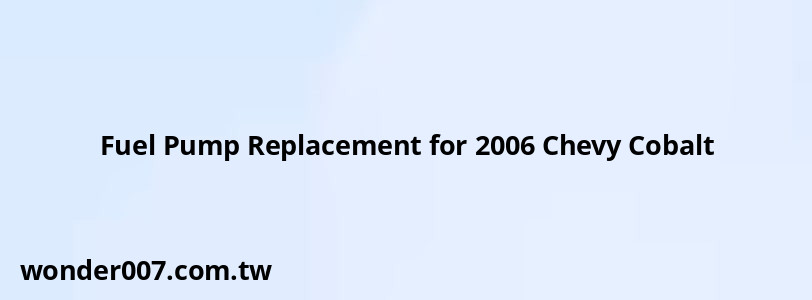Fuel Pump Replacement for 2006 Chevy Cobalt

The fuel pump is a critical component in your 2006 Chevy Cobalt, responsible for delivering fuel from the tank to the engine. If you're experiencing issues like engine sputtering, loss of power, or difficulty starting, it might be time to replace your fuel pump. This guide will walk you through the process of replacing the fuel pump in your Cobalt.
Symptoms of a Failing Fuel Pump
Before diving into the replacement process, it's important to recognize the signs of a failing fuel pump:
- Engine sputtering at high speeds
- Loss of power during acceleration
- Difficulty starting the engine
- Decreased fuel efficiency
- Whining noise from the fuel tank
If you're experiencing any of these symptoms, it's likely time to replace your fuel pump.
Tools and Materials Needed
To replace the fuel pump in your 2006 Chevy Cobalt, you'll need:
- New fuel pump assembly
- Socket set and ratchet
- Flathead screwdriver
- Fuel line disconnect tool
- Jack and jack stands
- Safety glasses and gloves
- Fuel-safe container
Replacement Process
Preparation
- Relieve fuel system pressure by removing the fuel pump fuse and running the engine until it stalls
- Disconnect the negative battery terminal
- Raise the vehicle using a jack and secure it with jack stands
Accessing the Fuel Pump
- Locate the fuel pump access panel under the rear seat
- Remove the rear seat cushion and the access panel
- Disconnect the electrical connector and fuel lines from the pump assembly
Removing the Old Pump
- Use the fuel line disconnect tool to detach the fuel lines
- Unscrew the retaining ring that holds the pump assembly in place
- Carefully remove the old fuel pump assembly from the tank
Installing the New Pump
- Compare the new pump to the old one to ensure it's the correct replacement
- Lower the new pump assembly into the fuel tank
- Secure the retaining ring and reconnect the fuel lines and electrical connector
- Double-check all connections before reinstalling the access panel and seat cushion
Finishing Up
- Reconnect the negative battery terminal
- Prime the fuel system by turning the key to the "On" position several times before starting the engine
- Start the engine and check for leaks
Important Considerations
- Always work in a well-ventilated area when dealing with fuel components
- Dispose of old fuel and parts properly according to local regulations
- Consider replacing the fuel filter at the same time as the pump for optimal performance
FAQs About Fuel Pump Replacement
- How long does a fuel pump typically last in a Chevy Cobalt?
A fuel pump in a 2006 Chevy Cobalt typically lasts between 100,000 to 150,000 miles, but this can vary based on driving conditions and maintenance. - Can I drive with a failing fuel pump?
It's not recommended to drive with a failing fuel pump as it can lead to engine damage or leave you stranded. - How much does it cost to replace a fuel pump professionally?
Professional replacement can cost between $400 to $600, including parts and labor.
By following these steps and taking proper precautions, you can successfully replace the fuel pump in your 2006 Chevy Cobalt. Remember, if you're not comfortable with this level of automotive work, it's best to consult a professional mechanic.
Related Posts
-
2015 Hyundai Sonata Water Pump Belt Replacement
31-01-2025 • 171 views -
How To Fix Check Fuel Fill Inlet
31-01-2025 • 156 views -
1995 Chevy Silverado AC Control Panel Troubleshooting Guide
30-01-2025 • 160 views -
Turn Signal Bulb Replacement for 2016 Hyundai Sonata
27-01-2025 • 171 views -
2012 Hyundai Sonata Tail Light Assembly: Replacement Guide
27-01-2025 • 178 views
Latest Posts
-
Power Steering Fluid Leak On Passenger Side
01-02-2025 • 468 views -
2015 Chevy Traverse AC Recharge Port Location
01-02-2025 • 425 views -
Are O2 Sensors Covered Under Warranty
01-02-2025 • 383 views -
Rear Brake Caliper Piston Won't Compress
01-02-2025 • 365 views -
How To Turn Off Paddle Shifters Mercedes
01-02-2025 • 393 views
Popular Posts
-
Hino Warning Lights: Understanding Dashboard Alerts
26-01-2025 • 820 views -
V12 Engine Costs: What You Need to Know
26-01-2025 • 697 views -
Power Steering and ABS Light On: Causes and Solutions
27-01-2025 • 656 views -
EPC Light: Understanding Causes and Solutions
26-01-2025 • 1077 views -
Toyota Hiace: Fuel Efficiency Insights for 2025
26-01-2025 • 675 views
